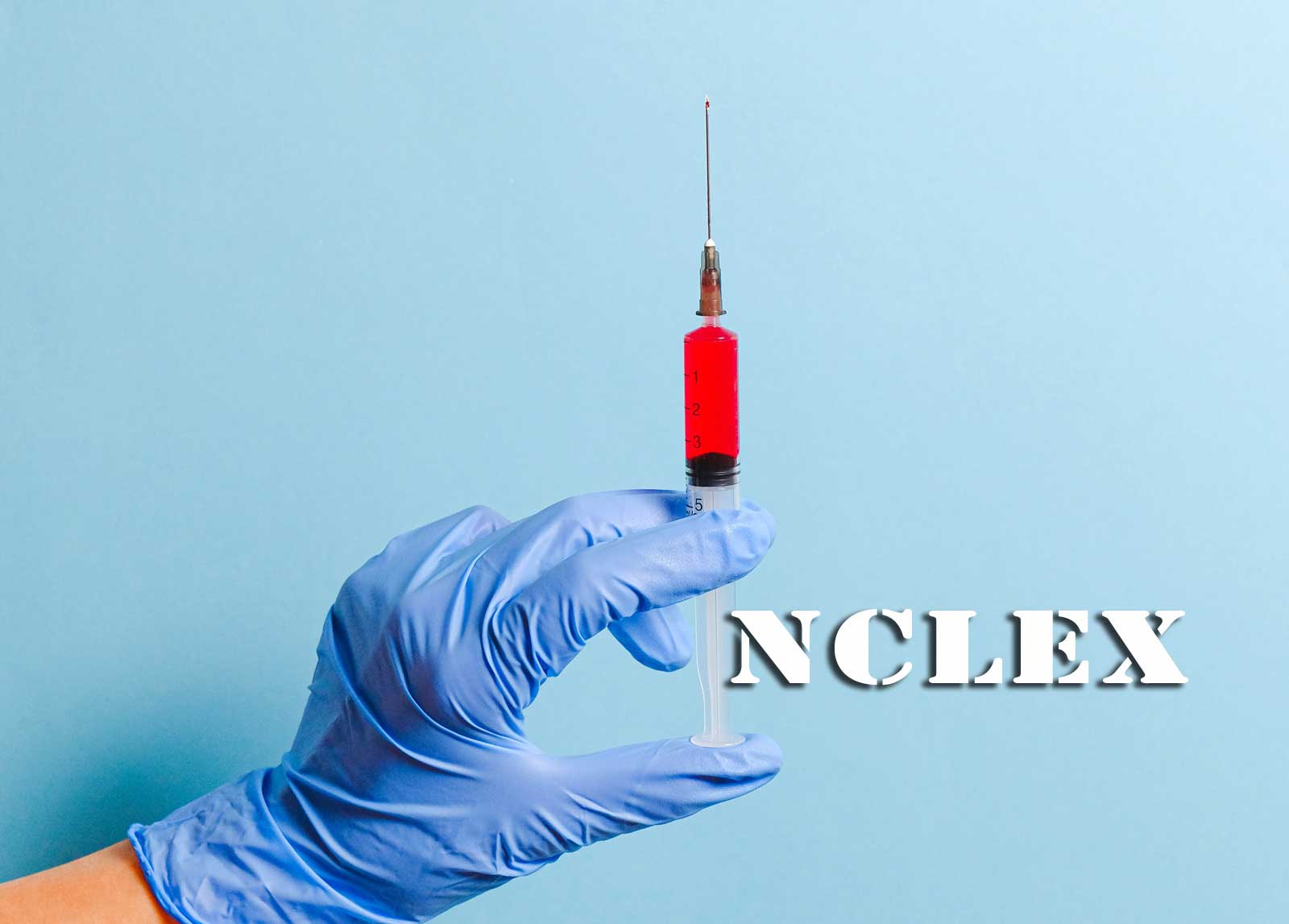NCLEX Genitourinary System Questions and Answers
NCLEX Genitourinary System Question Paper is given on our page. Check the Syllabus and Exam Pattern details for Genitourinary System in the section following. We advise referring the exam pattern before downloading the NCLEX Question Paper with Answers Pdf. Candidates who are looking for the NCLEX Genitourinary System Question Paper can get in this section. NCLEX PN Previous Papers helps the applicants during the preparation. We have given the direct link for NCLEX RN exam study material in the section below.
Download NCLEX Genitourinary System Syllabus and Exam Pattern from the below link. Make your preparation easy by preparing as per the National Council Licensure Examination Genitourinary System Syllabus. Also, check National Council Licensure Examination Question Papers from the below sections.

Genitourinary System Questions and Answers for NCLEX-PN and NCLEX-RN
1. The nurse is performing a urethral catheterization on a female. After separating the labia, where would the nurse observe the urethral meatus?
The urethral meatus in a female is located just below the clitoris and above the vaginal opening. When performing a urethral catheterization on a female, the nurse should separate the labia majora with one hand and use the other hand to identify the urethral meatus, which will appear as a small opening in the tissue. The catheter can then be inserted into the meatus and advanced into the bladder for urine drainage. It is important for the nurse to maintain sterile technique throughout the procedure to minimize the risk of infection.
2. An adult had an indwelling catheter removed. After she voids for the first time, the nurse catheterizes her as ordered and obtains 200 mL of urine. What is the best interpretation of this finding?
The finding of 200 mL of urine after catheterization following the removal of an indwelling catheter suggests that the patient did not completely empty their bladder during their first voiding attempt. This could be due to a variety of reasons such as discomfort, weakness, or incomplete bladder emptying due to an underlying medical condition. It is important to monitor the patient’s urinary output and any related symptoms, and report any significant changes to the healthcare provider.
3. The nurse is preparing to insert an indwelling catheter. What type of technique should the nurse use to perform this procedure?
The nurse should use aseptic technique when inserting an indwelling catheter. Aseptic technique is a set of procedures used to prevent the transmission of microorganisms from one person to another or from one part of the body to another. It involves using sterile equipment and maintaining a sterile field around the insertion site. The nurse should also wear sterile gloves and use sterile lubricant during the procedure. Aseptic technique helps reduce the risk of infection and ensures patient safety during the insertion of the indwelling catheter.
4. After inserting the indwelling catheter, how should the nurse position the drainage container?
After inserting an indwelling catheter, the nurse should position the drainage container below the level of the bladder to allow for proper drainage. The container should be placed on the floor or on a stable surface beside the bed, and should not be placed on the bed or any surface higher than the bladder level.
It is important to ensure that the drainage tubing is not kinked or twisted, and that the catheter is not pulled or tensioned by the tubing. Any tension or obstruction in the tubing can impede urine flow and increase the risk of catheter-related complications such as infection or blockage.
The drainage container should also be kept clean and emptied regularly to prevent overflow and contamination. The nurse should use appropriate infection prevention practices, such as wearing gloves and washing hands before and after handling the drainage system.
5. The nurse is attempting to pass an indwelling catheter in an adult male and is having difficulty. What is the most appropriate action for the nurse?
If a nurse is having difficulty passing an indwelling catheter in an adult male, the most appropriate action is to stop the procedure and reassess the situation. The nurse should not force the catheter, as this can cause trauma to the urethra and lead to complications such as bleeding and infection.
The nurse should first check to make sure that the catheter is the correct size and that the patient is in the proper position. The nurse should also check if the patient is experiencing pain or discomfort and consider using a local anesthetic to help with the procedure.
If the nurse is still having difficulty passing the catheter, they should consult with a healthcare provider, such as a physician or urologist, for assistance. In some cases, imaging may be needed to determine the cause of the difficulty and guide the catheter insertion.
Overall, the nurse should prioritize patient safety and comfort, and seek appropriate help if needed to ensure a successful catheterization procedure.
6. An adult client has returned to his room following a cystoscopy. When he voids, his urine is pinktinged. What is the most appropriate action for the nurse to take?
The presence of pink-tinged urine after a cystoscopy is a common finding due to the trauma caused to the bladder during the procedure. However, it is important to rule out any potential complications such as bleeding.
The most appropriate action for the nurse to take in this situation is to notify the healthcare provider immediately and document the findings. The healthcare provider will assess the client’s condition and determine if any further interventions or treatments are necessary.
In the meantime, the nurse should monitor the client’s vital signs and urine output, and encourage the client to drink plenty of fluids to help flush out any remaining blood or debris from the bladder. The nurse should also educate the client on what to expect and provide emotional support to help alleviate any anxiety or discomfort.
7. A urinalysis reveals white cells and bacteria in the urine of a female client suspected of having a bladder infection. The client is instructed to take the prescribed anti-infective. What else should the nurse include when teaching the client?
In addition to taking the prescribed anti-infective, the nurse should include the following information when teaching the client:
- Importance of completing the full course of medication as prescribed by the healthcare provider.
- The client should drink plenty of fluids, such as water, to help flush out the bacteria from the urinary tract.
- Good hygiene practices, such as wiping from front to back after urination, to prevent the spread of bacteria from the rectum to the urethra.
- The client should avoid irritants such as caffeine, alcohol, and spicy foods, which can aggravate the bladder and worsen symptoms.
- Symptoms to watch for, such as fever, worsening pain, or blood in the urine, which may indicate that the infection is not responding to treatment and further medical evaluation is needed.
- The client should inform their healthcare provider if they have any allergies or experience any adverse reactions to the medication.
- The client should inform their healthcare provider if they are pregnant or planning to become pregnant, as some antibiotics may not be safe during pregnancy.
- The client should schedule a follow-up appointment with their healthcare provider to ensure that the infection has been treated successfully.
8. An adult male is admitted with severe right flank pain, nausea, and vomiting of four hours in duration. The admitting diagnosis is a kidney stone. Orders include to encourage fluids to 1000 cc per shift. What is the primary reason for encouraging fluids in this client?
The primary reason for encouraging fluids in a patient admitted with severe right flank pain, nausea, and vomiting of four hours in duration due to a kidney stone is to promote hydration and increase urine output. Increasing fluid intake can help flush out the kidney stone and reduce the risk of urinary tract infections, which are common complications of kidney stones. Additionally, adequate hydration can help relieve symptoms of pain and discomfort associated with kidney stones. Overall, increasing fluids is an important part of the management of kidney stones.
9. The nurse is straining the urine of a client admitted with possible renal calculi. A small stone is discovered. What should the nurse do?
If a nurse finds a small stone while straining the urine of a client who has been admitted with possible renal calculi, the nurse should take the following actions:
- Notify the healthcare provider: The nurse should inform the healthcare provider immediately about the discovery of the stone. The healthcare provider may want to order further tests or imaging studies to evaluate the size and location of the stone.
- Monitor the client’s condition: The nurse should monitor the client’s vital signs and urine output closely. The presence of a stone can cause pain and discomfort, so the nurse should assess the client’s pain level and administer appropriate pain relief measures as needed.
- Encourage fluid intake: The nurse should encourage the client to drink plenty of fluids to help flush out any remaining stones and prevent the formation of new ones.
- Provide education: The nurse should educate the client about the importance of maintaining adequate fluid intake and dietary modifications to prevent the formation of future stones.
- Document the finding: The nurse should document the finding in the client’s medical record, including the size and location of the stone, and any interventions or education provided to the client.
10. A client who has kidney stones complains of pain. The nurse finds him pacing the hall. What is the most appropriate action for the nurse to take?
The most appropriate action for the nurse to take would be to assess the client’s pain level and provide pain management interventions. This may include administering pain medication as ordered by the healthcare provider, providing non-pharmacological pain management interventions such as positioning and relaxation techniques, and monitoring the client’s response to pain management interventions. The nurse should also assess the client for any signs of complications such as fever, chills, or blood in the urine, and report these findings to the healthcare provider. Additionally, the nurse should encourage the client to remain hydrated and follow any dietary recommendations provided by the healthcare provider to prevent further kidney stone formation.
11. The nurse is caring for a client who has acute renal failure. His potassium rises to 7.3 mEq/L. A Kayexalate enema is ordered. What is the primary purpose of the Kayexalate enema?
The primary purpose of a Kayexalate enema is to reduce the level of potassium in the blood. Kayexalate is a medication that works by exchanging sodium ions for potassium ions in the large intestine. This results in the elimination of excess potassium from the body through fecal excretion, thereby lowering the potassium levels in the bloodstream. In acute renal failure, the kidneys are not able to excrete excess potassium properly, leading to a buildup of potassium in the blood, which can be dangerous and even life-threatening. Therefore, the administration of a Kayexalate enema can help to lower the potassium levels and prevent complications associated with hyperkalemia.
12. A 67-year-old man is admitted with dysuria that has gotten worse over the past six months. Rectal examination revealed an enlarged prostate. Following urination, he was catheterized and found to have 250 cc of thick, foul-smelling, residual urine. He is admitted with a diagnosis of benign prostatic hypertrophy. Which symptom is least likely to be present in this client?
Benign prostatic hypertrophy (BPH) is a common condition in older men where the prostate gland becomes enlarged, leading to obstructive urinary symptoms. The symptoms associated with BPH can vary depending on the degree of obstruction and may include:
- Difficulty starting urination
- Weak urine stream
- Dribbling after urination
- Frequent urination, especially at night (nocturia)
- Urgency to urinate
- Incomplete emptying of the bladder
- Urinary retention
- Urinary tract infection
Based on the information given, the least likely symptom to be present in this client is “urinary tract infection.” While urinary tract infections can occur in men with BPH, it is not a specific symptom associated with the condition. The presence of foul-smelling residual urine, however, suggests that there may be an infection or other underlying issue with the bladder or urinary tract, which should be further investigated and treated accordingly.
13. A 35-year-old man asks the nurse about a vasectomy. In discussing a vasectomy with this man, which information is most important to provide?
As a nurse, when discussing a vasectomy with a 35-year-old man, the most important information to provide would include:
Vasectomy is a permanent form of contraception – The man should be aware that vasectomy is a permanent method of contraception, which means that it cannot be easily reversed if he changes his mind later.
Procedure details – The nurse should explain the procedure in detail, including how it is performed, how long it takes, and the type of anesthesia that will be used.
Potential risks and complications – The nurse should discuss the potential risks and complications associated with the procedure, such as infection, bleeding, and pain.
Post-operative care – The nurse should provide information about post-operative care, including how to manage pain, when it is safe to resume sexual activity, and what activities to avoid during the recovery period.
Effectiveness – The nurse should inform the man about the effectiveness of the procedure and how it compares to other forms of contraception.
Alternate forms of contraception – It’s important to discuss alternative forms of contraception in case the patient decides against a vasectomy, including the effectiveness, advantages and disadvantages of each option.
Counseling and decision-making process – The nurse should provide counseling and encourage the patient to have a thorough discussion with his partner about their family planning goals and decisions before making a final decision.
14. A client asks the nurse if he can get his wife pregnant after a vasectomy. What is the best response for the nurse to make?
The best response for the nurse to make would be to explain that a vasectomy is a permanent form of male birth control and that the chances of pregnancy after the procedure are very low, but not impossible. Sperm may still be present in the semen for a short period of time after the vasectomy, and it takes time to clear the existing sperm from the male reproductive system. Therefore, couples should use another form of birth control until a sperm count test confirms that there are no remaining sperm in the semen. If the couple desires to have children after a vasectomy, they may consider a vasectomy reversal or in vitro fertilization (IVF) with sperm retrieval. It is essential to consult with a healthcare provider to discuss the best option for them.
15. The physician has prescribed a diuretic for an adult client. Which nursing intervention is most important in relation to diuretic therapy?
The most important nursing intervention in relation to diuretic therapy is monitoring the client’s fluid and electrolyte balance. Diuretics increase the excretion of fluids and electrolytes, which can lead to dehydration and electrolyte imbalances. Therefore, the nurse should monitor the client’s intake and output, daily weights, and serum electrolyte levels. The nurse should also educate the client on the importance of maintaining adequate fluid and electrolyte balance and encourage them to report any signs or symptoms of dehydration or electrolyte imbalances, such as dizziness, weakness, muscle cramps, and irregular heartbeat. Additionally, the nurse should monitor the client for any adverse effects of diuretic therapy, such as hypotension, tinnitus, and gastrointestinal upset.
16. The nurse is caring for an adult who has an indwelling urinary catheter with a continuous bladder irrigation infusing. How should the nurse calculate the urine output when the drainage bag is emptied?
When caring for an adult with an indwelling urinary catheter with continuous bladder irrigation (CBI), the nurse should calculate urine output by measuring the volume of urine in the drainage bag and subtracting the volume of irrigation solution that has been infused.
To calculate urine output in this situation, follow these steps:
Record the volume of irrigation solution that has been infused since the last time the drainage bag was emptied.
Measure the volume of urine in the drainage bag when it is emptied.
Subtract the volume of irrigation solution from the total volume of urine and record the result as the urine output.
For example, if 500 mL of irrigation solution has been infused since the last time the drainage bag was emptied, and the drainage bag contains 1000 mL of fluid when it is emptied, the urine output would be calculated as follows:
Urine output = 1000 mL – 500 mL = 500 mL
Therefore, the nurse should record a urine output of 500 mL for that period.



